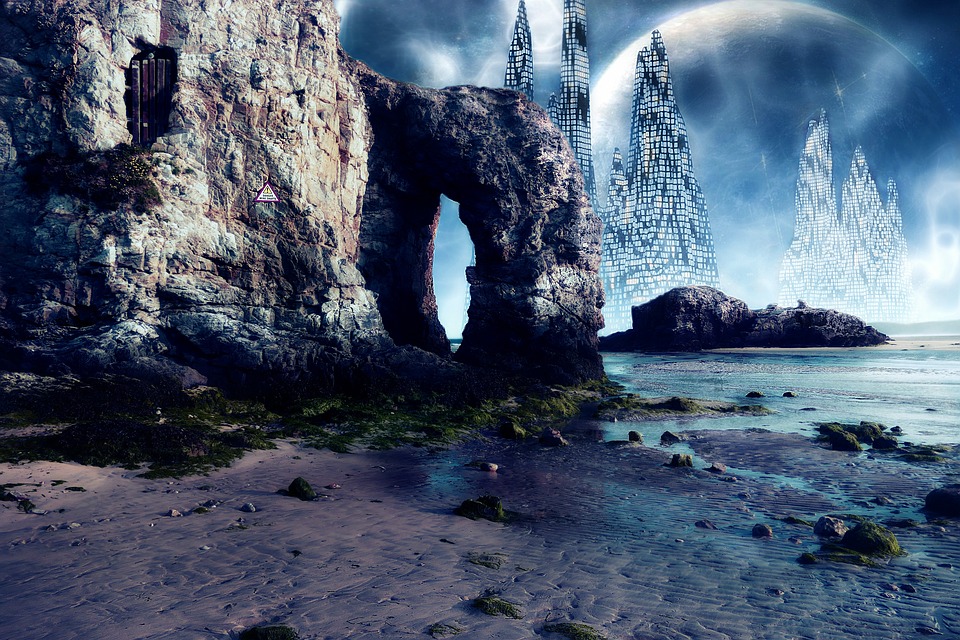Last week I shared insights from a great author panel at WorldCon76 in San Jose. This week I thought I’d share another.
The full title of this one was “How Would a Civilization Evolve If…: How Human and Nonhuman Concepts of ‘Universe’ Is [sic] Shaped By Their Environment.”
It was a fascinating chat between an astronomer, a biologist, and a — for lack of a better term – historian/philosopher. It reminded me of nothing so much as those classic sci fi tales where aliens arrive on earth and a team of varied scientific disciplines (and one guy out of left field) is assembled to understand the threat.
M Type Stars
The astronomer, Jonathan Fortney, started by pointing out how rare a sun like ours (a G type star) really is in the galaxy. It’s in the top top 10% of brightness – star of its class, really. Sorry. Couldn’t resist.
Most stars are “M type” – much fainter and redder than our sun. An astonishing 75% of all stars are M types.
Some interesting facts about the M type stars we’ve looked at:
- They almost almost never have “giant planet” protectors that could ward off the worst of interstellar or post-formation debris
- These types of stars tend to dim over time, unlike G types, which get brighter
- M type stars also have a lot of solar flares and put out a lot of uv light
- There is more infrared light than visible light in these systems.
- Some studies have suggested that plants could live off IR light.
- Smaller stars would also last longer than larger ones – 100 billion to a trillion years? The galaxy is estimated to be 13.7 billion years old now
- They do tend to have many rockier planets closer to the sun than Earth – for instance, you might have a planet at an 8 day orbit, one at 15, and one at 20, all in the same solar system.
- A 15 day orbit around one of these stars might be close enough for liquid water on the surface
- Often there are many planets very close together – visible to each other via the naked eye
- Worlds so close to their sun are also usually tidally locked, meaning one side always faces the sun, and one always faces away
- It was once thought that tidally locked worlds would lose their atmospheres as it froze out on the cold side, but recent theories suggest that if there’s enough atmosphere to begin with, energy transfer would result in enough turbulence and churn that the cold side would not freeze atmosphere out
Some of the ramifications for life on such planets:
- Organisms in an Infrared world might not develop eyes. Needhi Bhalla, the biologist, discussed a theory that maybe Earth organisms developed light sensitivity as away to avoid damaging light, and this eventually led to the evolution of our eyes
- Because the world would be tidally locked, you might have different evolutionary selection processes on each side
- Telling time (especially in the longer term) would require different mechanisms and a different circadian clock, because there would be no “day” and “night and possibly no “seasons”
- On the topic of seasons – if the planet was tilted, or followed a perturbed orbit, this could cause “seasonal” variations of temperature.
- Humans or other intelligent life would have to come up with a way to “explain” the sporadic input of extra solar energy from flares? Martin Devecka, the historian, said that Earth’s volcanoes could give us a clue – they also create effects in the sky. “People would get used to the world ending all the time.”
One interesting side-note that came up. The astronomer suggested that it would be much easier for people to see how the solar system worked, and harder for supernatural or false explanations to arise.
The historian countered that people would find a way, and said that the moon’s phases were once seen as the result of the souls of the dead piling up on it.
Circumbinary Planets
Then the panel talked about another type of system – those with circumbinary planets that are in orbit around two primary stars.
All of the circumbinary planets we’ve found so far are gas giant size, in simikar orbits of 100-150 days. These planets are not tidally locked, and their rotation seems random, based on how planet accreted initially.
Other Factors
The biologist mentioned “The Expanse,” and how the show dealt with the effects of gravity and force (and the lack thereof) on humans. She was fascinated by the idea that living on an asteroid would change your physiology and appearance, and therefore lead to discrimination in wider human culture. Apparently cells respond to “force” (like a gravitational force” and behave differently depending on the amount of force applied.
One of the panelists brought up the “Hyperion Series.” In the books, there are unlimited resources, and because of this, there’s no need for a hierarchy to distribute them in society. Such hierarchies often spring initially from scarcity and the distribution of resources via an agrarian society, which often forms when humans don’t have the ability to leave and must stick together to survive.
On a related note, the historian pointed out that in societies of scarcity, people tend to “create” abundance by subdividing the scare things into many sub categories.
Someone asked if aliens might be based on something other than a version of DNA. The biologist pointed out that the first living cells used RNA instead of DNA, but RNA is much less stable. She also pointed out that our own “solution” to the creation of life isn’t necessarily the only one – just the final product of many false starts in evolution on Earth.
The panel discussed the hard radiation you might expect on an alien world, especially close to an M Type star – and the biologist pointe out that slugs and roaches have something called radiodurance – meaning they can withstand a lot more radiation than humans and other animals can without significant cellular damage.
Also, animals like the tardigrade can withstand dessication – being completely dried out. Experiments are ongoing to discover how, with some scientists suggesting that it has to do with specialized proteins.
One more biological note – she mentioned peto’s paradox – as animals get bigger, they need to go through rapid changes and many body plans as they grow from a single cell – so the bigger a life form is, the more opportunity there is for cellular damage, meaning they should get cancer more often. But it’s not always the case. Some animals – including elephants and naked mole rats – seem to have a workaround – a duplicative set of genes that functions as a backup set to repair cellular damage.
It was a fascinating panel – one of those where you feel smarter just having been there to witness it.
What interesting factoids have you come across about how life might evolve on non-earthlike worlds? Links?

